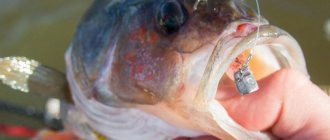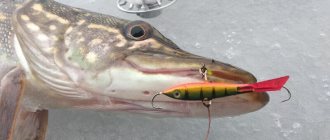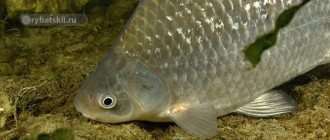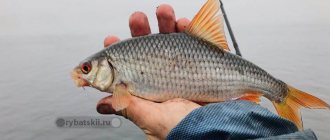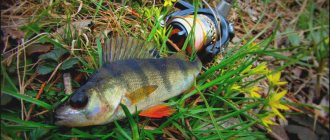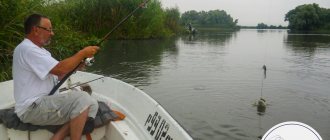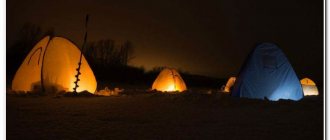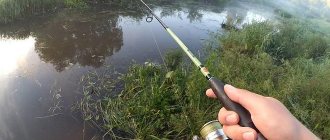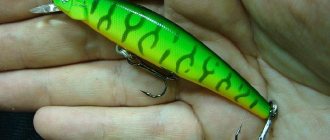Where to look for perch in autumn
The first task of any fish before a long and difficult period is to gain fat. This is exactly what perch does throughout the fall. Flocking into numerous flocks, he spends his day hunting. Constantly pursues young peaceful fish - the main and constant diet of the predator.
Where there is a school of white fish, all predatory fish, from small to large, are sure to be there. Do not forget that the real threat to all inhabitants of the reservoir is pike and pike perch. Therefore, places with natural shelters are the best for a spinning fisher: a striped fish can hide behind snags, bushes, flooded trees, and not yet completely fallen algae.
With each autumn month the weather becomes harsher, temperature, pressure, wind change - all this dictates its own rules. Below we will look at where the fish will most often stand depending on the time.
September
Perch continues to stick to the coastal zone and shallow depths, as the water has not yet cooled down and remains attractive for whitefish. In September there are often warm, clear and sunny days, especially during Indian summer. The rays warm up the shallows where the grown fry are basking, attracting the striped fish.
It is not uncommon for seethings and movements near the surface to be visible to the naked eye in a body of water. Small things often jump out of the water, sometimes as if running across the surface of the water. All this is a sign of a feeding perch attacking a school of its prey.
When casting along the so-called boiler, you are sure to have a catch. If such a place is not visually visible, then start fishing the coastal zone with a fan, looking for small holes, snags, grass and other shelters. The bite does not deteriorate throughout the daylight hours.
October
Fishing in October brings an inconsistent bite. Changing temperature and pressure make themselves felt, negatively affecting activity. There are fewer and fewer days with stable weather, so fishing often becomes a roulette.
The perch, following the peaceful fish, begins its slow movement towards the deep parts of the reservoir. The edges are becoming one of the best places to start your search. Don’t forget about the standard places that we wrote about above. Instead of spinners, spinners are increasingly equipped with silicone or microjigs for fishing the bottom layer.
November
In late autumn, deep holes and dumps become the main habitats. It is rare that the bite will be in the coastal zone with shallow depths. The flocks have finally moved to the depths, where they can only be reached with jig baits or wobblers with deep depth.
The predator's feeding time is only during the day, with varying success. The water cools more and more quickly, the air temperature decreases, and the pressure often changes. Having guessed a good day, you can catch the last zhor and make the most of it. But, unfortunately, it is not uncommon when the bites are not at all pleasing.
When does the cravings begin?
Depending on the region of Russia, this is the middle and second half of September. There is no more precise date for the autumn zhora. Everything is at the disposal of nature, so much depends on it. If September turns out to be warm for its time, then the bites are pleasingly frequent.
A decrease in water temperature to 15 degrees and stable weather conditions have a beneficial effect on the mood of the fish, causing a desire to fatten up and put on fat.
Selection of location and fishing tactics
Before catching perch with a spinning rod, you need to find the habitats of this fish. In autumn, predators try to stay in areas with warm water, for example, in depressions in the bottom of a reservoir. On the rivers they look for perch:
- in snarled places;
- in areas with standing water and sandy bottom;
- in deep holes;
- When fishing from a tray, the location of the fish can be determined using a special device, an echo sounder.
For many, it remains a secret how to catch perch in the fall, because the habits of the fish during this period of the year differ from their behavior in the summer. They hunt for predators in the early morning or at noon. In the evening, the fish becomes slow and inactive. In sunny weather, perch bites well, but it is almost impossible to catch it during changes in atmospheric pressure, as well as in rainy weather.
After determining the location of the fish, cast a spinning rod equipped with a jig or spoon. If the baits used do not produce results, then it is necessary to change the wiring technique or the color of the bait. After casting, the bait sinks to the bottom of the reservoir (the line should sag). When a bite occurs, wait for 3-5 seconds, make a hook and begin to land the fish.
What weather and what hours are the best results?
The first and most important condition is stability of weather conditions. Sharp changes in atmospheric pressure at any time of the year have a negative impact on peaceful and predatory fish, reducing the bite. If the same remains for several days, this is an excellent sign of an upcoming bite.
The best weather for fishing is sunny, windless, calm days. At dawn there is a high chance of confident perch bites. Then there is a lull until 10-11 o'clock. Then you can continue fishing throughout the day, up to 18 hours. As evening approaches, the bite subsides and remains unchanged until the next morning.
Gear used
- A universal option would be a good light rod with a cast weight of up to 10-15 g, which allows you to catch not only perch, but also pike. A separate class can be distinguished by ultra light (ultralight) spinning rods, with tests of 3-7 g, the micro baits used give excellent results for striped fish. For the bank of a large river, a length of 3-3.5 meters is preferable. For micro rivers and small lakes, 1.90-2 meters is enough. These sizes are ideal both for a boat and for overgrown banks, where it is impossible to swing with a long blank.
- Fast and medium-fast action is the choice of most spinners. It allows you to make long and accurate casts to the fishing point, without losing its sensitivity during casting.
- A 2000 size reel is sufficient. It is important to wind the braid correctly: there should be a few mm left to the edge of the spool edge. If this rule is neglected, then loops may be dropped and poor winding may occur. The casting distance will also be reduced.
- Braid with a diameter of 0.10-0.12 mm is ideal for light and 0.6-0.8 mm for ultra-light spinning. The diameter of the monofilament line is 0.18-0.22 mm.
What to fish for and how to choose the best bait
There are no special autumn baits; they are all the same for any season of open water. They are selected depending on the conditions and locations of the perch. For example, at the beginning of the season, surface types such as poppers and spoons are preferable due to fishing in the upper layers. In the second half and late autumn, wobblers with deep depth and silicone with a heavy jig dominate, since the fish goes to depth, it is necessary to look for it at the bottom.
Rotating and oscillating spoons
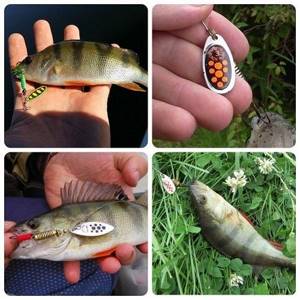
The ideal option would be rotators with petal size No. 0-3. They are used at any time of the year and work great. It is especially worth noting the form of Aglia and Aglia Long, who constantly delight with their catches. Natural colors of copper, gold, silver are relevant at any time of the day.
Spoons in the area of 4-6 cm are universal, allowing you to catch different sizes of fish. Don’t be afraid of 60 mm models; in the fall, the perch is fattened and less timid, greedily grabbing everything it sees. In both the first and second cases, the weight of the iron matters. Try to play not by increasing the petal, but by the weight of the core. For example, 9 gram baits are universal: in calm conditions and in the wind they show good results in terms of accuracy and casting range. Lures weighing 4-6 grams are more convenient to use in calm weather.
What size and depth of wobblers is priority?
For surface fishing at the beginning of the season, poppers, cranks and minnows with the smallest depth are used. Sizes vary from 3-7 cm, these are the most popular options. The colors are closer to natural, since reservoirs at this time have clear water, and acidic colors can scare away predators. In the future, until the end of the spinning season, it makes more sense to fish with medium and high depth.
It is important to have an idea of the depths of the reservoirs where you catch perch. Based on this, mount the bait that will pass at the very bottom. Most often it is 1.8-2.5 meters. If there is no bite, change the type from sinking to suspending or floating. It is impossible to predict who the striped robber will be annoyed with and which of them will be the most catchy today.
Silicone baits
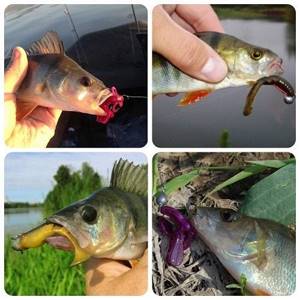
Twisters, vibrating tails and worms will be the best choice. The difference is in their game. If the perch is active, then twisters and vibrotails are suitable, creating good animation under water. For passive biting, the spinning rod is equipped with worms or slugs, which essentially do not have their own game. That is why it is easier for novice fishermen to start with active varieties of baits.
Silicone baits are divided:
- twisters
- vibrotails
- worms (slugs)
- crustaceans (krakozyabry, nymphs)
When fishing with crustaceans and the like: we advise beginners to use “drag” wiring - we talked about it below. To the perch, this resembles a moving juvenile crayfish, and it does not miss the chance to feast on it. Actively playing claws and whiskers (in nymphs) additionally provoke the striped one to attack.
Spinning rigs for perch
All equipment is divided into 2 main types:
- classic
- spaced
Each of these species has its admirers, but besides this, the installation is selected depending on the fishing location. For example, in heavily snagged or overgrown places one type is convenient, in water with a clear bottom another, and so on.
Exploded Views:
- Retractable leash. The most famous montage. A double or triple swivel is tied to the main line. A piece of fishing line 10-15 cm long with a stick-shaped weight is mounted to its lower eye (provides the best maneuverability in hard-to-reach places). Another segment of 30-40 cm with an offset and bait is tied to the last free ear.
- Drop shot. Designed for spot, vertical fishing. Useful, for example, in water lilies, where perch often stands. A weight is tied to the end of the main line. Above it, at a distance of 30-50 cm, an offset blanket is tightly knitted, with the tip up. Thanks to precise casting, the bait stays in place; just twitching the rod up and down is enough to animate it. It performs very well in the current, where throwing the movement of the water will do everything for you, forcing the vibrating tail to play.
- Caroline. Invented in the States for bass fishing, it has taken root well in Russia. A bullet weight is threaded onto the main line, then a bead is inserted and a swivel is tied. A 15-20 cm piece of fishing line with a hook is mounted to the latter. It works well in overgrown and snagged places; it is important that the load in the gear is sliding.
Classic installation:
- A Cheburashka weight or jig head is attached to the braided line.
- An offset hook clings to the eared sinker
- A bait is mounted on the offset machine
An important point is the freedom of movement of the hook; its eye should be large. Thus, under water, the bait naturally plays and attracts perch. The classic option is used by both beginners and experienced fishermen.
Pros:
- Simple and knit on the knee
- Does not require special skills
- Any wiring possible
- When using a leash, the load changes quickly
What wiring to use
- Stop and go (stop&go). Several turns of the coil are made, a pause of 2-5 seconds is waited, and the actions are repeated. It is more often used when fishing with wobblers; in jig there is a similar wiring called a “step”.
- Step (stepped). The bait falls to the bottom, pause, make 1-2 turns with the reel, pause. The waiting time, as well as the number of revolutions, can be changed in either direction. Classic wiring for jig baits.
- Uniform. Used for wobblers with their own game and all spinners. As the name suggests, the cord is wound evenly. The spoon can be played either on the verge of stopping the petal or at a fast pace.
- Ryvkovaya (twitch). An excellent option for a wobbler. A short swing of the tip of the spinning rod is made to the side, at the same time the bait moves forward by inertia. The released line is reeled in by a reel. Variations with additional pauses and double jerks are possible. They can be either short or long, even broaches.
- Wave. While moving the lure evenly, swing the rod tip up and down. The bait will repeat these movements underwater.
What bait does perch prefer in the fall?
If in the summer a striped predator could easily be caught with a worm or a leech, then with the arrival of autumn it is recommended to replace such bait with live bait. Malek is not always available to the fisherman, so many people use artificial fish.
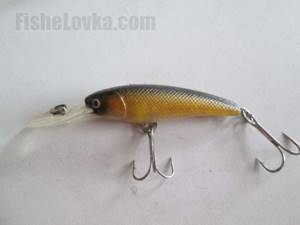
Photo 2. Minnow with depth will find perch in the lower layers of water.
When choosing a bait for catching perch on a spinning rod, you should pay attention to silicone for jig. When installed correctly, such a product imitates the movement of live bait, thereby attracting a predator. Experienced fishermen in the autumn recommend using artificial fry of different shades, for example, brown or pearlescent, as well as dark green.
The optimal length of bait for a perch jig is considered to be 5 centimeters; this is quite enough to attract the attention of a large predator.
Another effective type of bait for perch in the fall is a spinner. The main advantage of such a product over silicone ones is the casting range and accuracy. Spinner baits also have a drawback; they are not recommended for use in fast-flowing sections of the river. Such a bait will not reach the bottom, and this is especially important, because perch lives in the bottom layer in the fall. On the river, the spoon can be replaced with a deep-sea wobbler.
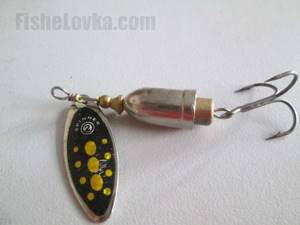
Photo 3. Pinwheels always tempt minke whales.
Catching pike and perch on a spinning rod in the fall using natural worm or maggot baits will not bring the desired result. In the autumn period of the year they use live bait and here's why:
- The fry moves along a familiar trajectory, unlike artificial baits.
- A drop of blood that forms when the fry is placed on a hook helps to attract the attention of a striped predator.
- A perch can notice a fry even in a flowery pond; it is accustomed to such prey.
In addition to the advantages, live bait also has weaknesses:
- the need for periodic replacement of fry;
- fish can wag and cling to coastal vegetation;
- high price of live bait.
Each fisherman chooses bait or bait independently based on capabilities and personal preferences, but to get a good catch you need to take with you not only live bait, but also several types of wobblers or spinners.
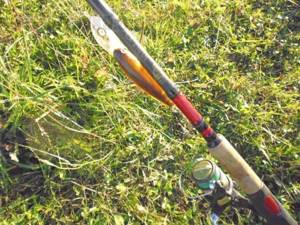
Photo 4. Ultralight tackle set for perch.
Useful tips
- The cooler it gets, the deeper the perch go
- Using a boat and getting to hard-to-reach places will increase your chances of success
- If you don’t bite on a classic rig, try a retractable leash
- Where there are peaceful fish there is always a predator
- In case of lack of oxygen, the fish slides to depth
- Striped activates with water temperature of 15 degrees
- Be in constant search, do not throw your spinning rod in one place
- With the arrival of cold weather, perch gather in schools, and if you find one, you will provide yourself with a catch
Perch spawning
Perch, like any other fish, lives on an annual cycle. The main milestone in this cycle is spawning. During the spawning period, the fish “ignores” any feeding and bait.
Spawning conditions are:
- reservoir temperature. As with all representatives of the “Pisces” class, perch spawning cannot be “tied” to the calendar. It depends on the temperature of the reservoir. As soon as the water warms up to ten degrees, the fish begins to spawn.
- Spawning time: early morning;
- spawning site: perch chooses shallow water areas;
- lack of river flow;
- “water landscape”: the presence of vegetation, snags, old reeds;
- high oxygen content in the water, without which the eggs die.
Considering that the perch has gone to spawn, anglers distinguish two fishing periods:
- before spawning;
- after spawning.

